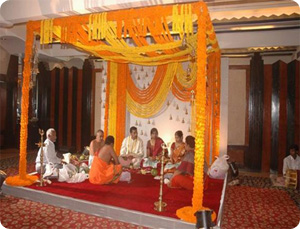Tamil Wedding Rituals

Tamil wedding rituals are very elaborate. They involve a number of ceremonies that are performed to ensure that the bride and the groom, who are going to tie the wedding knot, enter their new phase of life in the most elegant manner. A number of ceremonies revolve around the wedding, which is very charming to look at. Every stage of the rituals is performed with religious observance. The ambience is filled with festivity. You would be highly enthusiastic about what is going to happen next, if you witness a typical Tamil Brahmin wedding. Go through the following lines to know more about the Tamil Brahmin wedding rituals.
Tamil Wedding Customs
Mangala Snaanam & Kashi Yatra
After applying oil, and a tilak of haldi-kimkum, the bride and the groom take the mangala snaanam (holy bath) at the respective homes, on the dawn of the wedding day. After having the mangala snaanam, the bridegroom pretends that he is leaving for Kashi and he is no more interested in performing the role of a householder. He stops only when the girl's father persuades him to take the responsibility of his daughter, by marrying her. Then the groom heads his way for the wedding pandal, where the bride and her family receives him. This beautiful custom is known as kashi yatra.
Exchange Of Garlands & Oonjal
After the groom enters the pandal, he exchanges garlands for three times with the bride. This ceremony is full of fun and frolic. Thereafter, they are seated together on a swing. Married women give the newly weds spoonful of milk and banana pieces to eat.
Kanyadaanam & Muhurtham
As the groom reaches the mandapam, the bride's father welcomes his son-in-law. The groom's mother-in-law puts kajal in his eyes. Thereafter, his father-in-law washes his feet, considering him as God. The bride is then seated in her father's lap with a coconut in her hands. Thereafter, the bride and her father offer coconut to the bridegroom. In the meantime, the bride's mother puts water over the coconut. This gesture symbolizes the kanyaadaan of their daughter. The bridegroom's family presents their daughter-in-law a nine-yard sari that she has to wear, when the mangalsutra will be tied around her neck.
Seeking the help of her sister-in-law and aunts, the bride wears the nine-yard sari and enters the mandapam. A sack of paddy is kept on the floor and the bride's father is made to sit on it. The bride is asked to sit on her father's lap. Paddy represents abundance and good fortune. The yoke of a farmer's plough is taken and touched to the forehead of the bride. It is done with the hope that the couple will always walk together. The priest and the relatives touch the Mangalsutra and thereby, bless the newly wedded couple. Thereafter, a sacred yellow thread is handed over to the bridegroom, which he puts around his wife's neck and ties two knots. The third knot is tied by the groom's sister. The three knots symbolize the union of the mind, spirit and body.
Saptapadi
The bridegroom takes his wife's right hand in his left hand and leads her around the holy fire for seven times. In every round, she touches her feet to the grindstone hoping that their union will be firm forever.
| |
Other Categories
Tamil Pre-Wedding Rituals
Tamil Wedding Rituals
Tamil Post-Wedding Rituals
Main Categories
Indian Weddings
Wedding Decoration Tips
Pre Wedding Functions
Post Wedding Functions
Hindu Marriages
Indian Wedding Day Functions
Muslim Wedding Ceremony
Malayalee Wedding Ceremony
Kannada Wedding Ceremony
Kashmiri Wedding Ceremony
Oriya Wedding Ceremony
Tamil Wedding Ceremony
Bengali Wedding Ceremony
Punjabi Wedding Ceremony
Jain Wedding Ceremony
Maithil Brahmin Wedding Ceremony
Sindhi Wedding Ceremony
Telugu Wedding Ceremony
Maharashtrian Wedding Ceremony
Assamese Wedding Ceremony
Jewish Wedding Ceremony
Marwari Wedding Ceremony
Buddhist Wedding Ceremony
Gujarati Wedding Ceremony
Planning Your Honeymoon
Indian Bride
Indian Groom
Indian Wedding Features
Marriage Problems
Indian Wedding Preparation
Indian Wedding Planners
Post Wedding Preparation
Main Day Function
|

